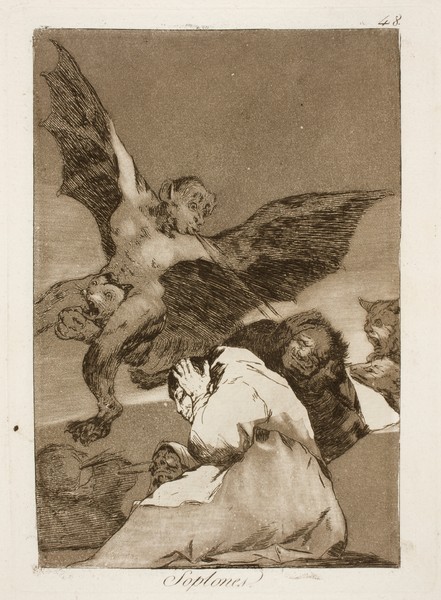- Cronología
- Ca. 1797 - 1799
- Dimensiones
- 208 x 153 mm
- Técnica y soporte
- Etching and burnished aquatint
- Reconocimiento de la autoría de Goya
- Undisputed work
- Titular
- Ailsa Mellon Bruce Collection
- Ficha: realización/revisión
- 20 Dec 2010 / 29 May 2024
- Inventario
- 225
Soplones. (at the bottom)
48. (in the upper right-hand corner)
See Francisco de Goya y Lucientes, Painter.
There is only one known proof of the condition before additional burnishing, which shows a high level of luminosity. It shows a trace of ink in the left margin and the handwritten number 48 on the imprint of the plate.
A preparatory drawing of this engraving is in the Prado Museum.
Three witches cover their ears to avoid being blown away by the demonic creature that flies over them with its wings spread out on the back of a cat. This infernal being has spread wings and feline claws. They are also met by the sucking of a pair of buttocks that are directed towards the face of the warlocks. On the right are the heads of two animals, one of which has horns and its jaws open as if it were screeching.
The etching of the print has very well-defined lines, the aquatint is single-tone and was passed through the burnisher before the lettering was engraved.
The Prado manuscript interprets this scene as a pun on the title, which comments on the witches' lack of intelligence: "Los Bruxos soplones son los mas fastid.s detona la Brux.a y los menos yntelig.s en aquel arte. si supieran algo no se meterian à soplones". However, the manuscript of the National Library gives a different reading: "The auricular confession serves only to fill the ears of the friars with filth, obscenities and filth". It is possible, as in other engravings in this series, that the image has a double meaning.
One of the visual sources for this print must have been the Self-belief celebrated in the city of Logroño on 6 and 7 November 1610 by Leandro Fernández de Moratín (Madrid, 1760-Paris, 1828). In it he mentions the witches who confessed to the devil, although here the term "snitch" can be identified with "informer", thus Goya satirizes those who denounced other people to the Inquisition.
For other specialists, this work could be a criticism of the confessions made to clerics, as the figure in the foreground looks like a monk wearing a habit, which would tie in with the interpretation provided by the manuscript in the National Library.
The plate is in rather poor condition, with the aquatint lost ( National Chalcography, no. 219).
-
Goya. Gemälde Zeichnungen. Graphik. TapisserienKunsthalle BaselBasle1953from January 23th to April 12th 1953cat. 326
-
El arte de GoyaMuseo de Arte Occidental de TokioTokyo1971from 16th 1971 to January 23th 1972. Exhibited also at the Kyoto Municipal Museum of Art, January 29th to March 15th 1972.cat. 74
-
Goya dans les collections suissesFundación Pierre GianaddaMartigny1982consultant editor Pierre Gassier. From June 12th to August 29th 1982cat. 40
-
Goya. La década de Los CaprichosMadrid1992organized by Real Academia de Bellas Artes de San Fernando sponsored by Fundación Central Hispano, Madrid, consultant editor Nigel Glendinnig. From October 26th 1992 to January 10th 1993cat. 110
-
GoyaNationalmuseumStockholm1994consultant editors Juan J. Luna and Görel Cavalli-Björkman. From October 7th 1994 to January 8th 1995cat. 66
-
Francisco de GoyaMuseo d'Arte ModernaLugano1996exhibition celebrated from September 22nd to November 17th.cat. 48, p.75
-
Francisco Goya. Sein leben im spiegel der graphik. Fuendetodos 1746-1828 Bordeaux. 1746-1996Galerie KornfeldBern1996from November 21st 1996 to January 1997cat. 54
-
Goya e la tradizione italianaFondazione Magnani RoccaMamiano di Traversetolo (Parma)2006consultant editors Fred Licht and Simona Tosini Pizzetti. From September 9th to December 3th 2006cat. 48, p.157
-
Goya. Opera graficaPinacoteca del Castello di San GiorgioLegnano2006exhibition celebrated from December 16th 2006 to April 1st 2007p.36
-
Goya e ItaliaMuseo de ZaragozaZaragoza2008organized by the Fundación Goya en Aragóna, consultant editor Joan Sureda Pons. From June 1st to September 15th 2008cat. 332
-
Goya et la modernitéPinacothèque de ParisParís2013from October 11st 2013 to March 16th 2014cat.7
-
Goya engravings and lithographs, vol. I y II.OxfordBruno Cassirer1964p.121, cat. 83
-
Vie et ouvre de Francisco de GoyaParísOffice du livre1970p.182, cat. 547
-
Goya, 1746-1828. Biografía, estudio analítico y catálogo de sus pinturasBarcelonaEdiciones Polígrafa s.a.1970p.396, fig. 647
-
Goya, la década de los caprichos: dibujos y aguafuertesMadridReal Academia de Bellas Artes de San Fernando1992pp.185-187, cat. 109-110
-
Goya. El capricho y la invención. Cuadros de gabinete, bocetos y miniaturasMadridMuseo del Prado1993pp.213-214, fig. 152
-
Catálogo de las estampas de Goya en la Biblioteca NacionalMadridMinisterio de Educación y Cultura, Biblioteca Nacional1996p.99, cat. 137
-
El libro de los caprichos: dos siglos de interpretaciones (1799-1999). Catálogo de los dibujos, pruebas de estado, láminas de cobre y estampas de la primera ediciónMadridMuseo Nacional del Prado1999pp.262-265
-
ParísPinacoteca de París2013p. 65
-
Goya. In the Norton Simon MuseumPasadenaNorton Simon Museum2016pp. 42-75

